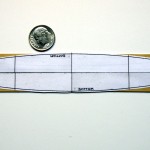 Unlike many canoes, this one has a flat bottom. It is very much like a dory bottom, flat, wide, and with a very slight bit of rocker (fore and aft curvature). One of the benefits of this sort of bottom is relatively high “initial stability,” meaning that it isn’t as tippy as a narrow round bottom or v-bottomed boat might be when you first step in to it. It’s also very easy to construct.
Unlike many canoes, this one has a flat bottom. It is very much like a dory bottom, flat, wide, and with a very slight bit of rocker (fore and aft curvature). One of the benefits of this sort of bottom is relatively high “initial stability,” meaning that it isn’t as tippy as a narrow round bottom or v-bottomed boat might be when you first step in to it. It’s also very easy to construct.
We won’t find boards wide enough for the full width, nearly 15 inches. So, we edge glue as many boards as needed to make up the width. Due to lumber availability, the 1:1 version will likely require 3 boards, and that is what I did for the model. These joints are probably the most critical in the boat. They are edge joins of boards that are 9/16 inch thick, and are fastened solely with glue. The edges have to mate as close to perfectly as possible. They will be a good place to use a #8 jointer plane.
The photo shows how I simply cut out parts of the drawings and rubber cement them to the actual parts for cutting. The technique minimizes a lot of measuring and the errors that come along with measuring.
Click on the image to show a larger version.
Leave a Reply